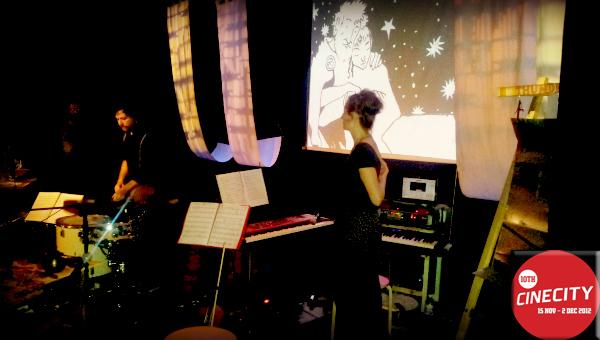Who is that handsome, bare chested motorcyclist, nonchalantly overtaking characters from EASY RIDER? Why, it’s Odysseus’ son Telemachus of course! Wait, what?
At the start of a Paper Cinema performance, looking down at the piles of equipment (hundreds of cardboard cutouts) it’s hard to know what to expect. There is the initial worry that this will be a charming but over-quaint affair. As soon as Nicholas Rawling (Artistic Director and one of the two principal puppeteers) stepped up to a large sheet of parchment and started ink drawing the title sequence LIVE to introduce all the characters, any such worries were dashed. A simple idea but such a joy to watch.
To spend much time discussing the plot of Homer’s Odyssey, reimagined and retold here by The Paper Cinema, would be burying the lead. The real story here is how the tale is presented. If Terry Gilliam decided to perform one of his animated Python cut scenes live, using cardboard cutouts, held in front of a camera, and cleverly manipulated, that might give you a rough idea. Even that would be selling the spectacle short, however, as there are actually FOUR cameras (that I counted), and the scenes that they film are digitally combined on screen for us to watch. Really has to be seen to be believed (or even fathomed).
Telemachus follows his father’s trail (on his motorbike of course), hoping to learn of his fate…
So back to the story of Homer’s Odyssey. After the Trojan War, Odysseus embarks on a 10 year journey, during which he will confront gods, monsters, bad weather and his own mortality. After a while, his wife Penelope and son Telemachus presume him dead, causing Penelope to attract the attention of many unsavoury suitors (portrayed here as ravenous wolves). Telemachus follows his father’s trail (on his motorbike of course), hoping to learn of his fate.
There is virtually no dialogue, but the sound and music is all performed live on keyboards, drums, violins, saw, and a variety of other instruments. The nature of the production leads the audience to a confusing dilemma, though. At the end of a piece of music/scene, do we clap? We’ve just watched 5 people performing on stage, do we REALLY wait till the end to clap?


